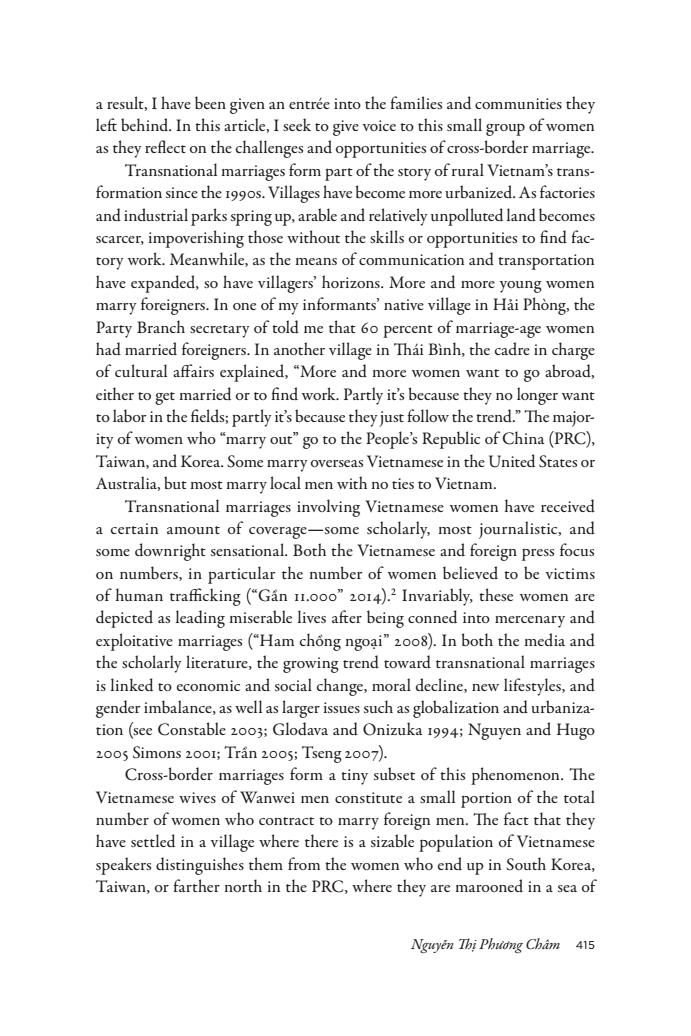正在加载图片...

a result,I have been given an entree into the families and communities they left behind.In this article,I seek to give voice to this small group of women as they reflect on the challenges and opportunities of cross-border marriage. Transnational marriages form part of the story of rural Vietnam's trans- formation since the 199os.Villages have become more urbanized.As factories and industrial parks spring up,arable and relatively unpolluted land becomes scarcer,impoverishing those without the skills or opportunities to find fac- tory work.Meanwhile,as the means of communication and transportation have expanded,so have villagers'horizons.More and more young women marry foreigners.In one of my informants'native village in Hai Phong,the Party Branch secretary of told me that 6o percent of marriage-age women had married foreigners.In another village in Thai Binh,the cadre in charge of cultural affairs explained,"More and more women want to go abroad, either to get married or to find work.Partly it's because they no longer want to labor in the fields;partly it's because they just follow the trend."The major- ity of women who"marry out"go to the People's Republic of China(PRC), Taiwan,and Korea.Some marry overseas Vietnamese in the United States or Australia,but most marry local men with no ties to Vietnam Transnational marriages involving Vietnamese women have received a certain amount of coverage-some scholarly,most journalistic,and some downright sensational.Both the Vietnamese and foreign press focus on numbers,in particular the number of women believed to be victims of human trafficking("Gan 1.ooo"2014).2 Invariably,these women are depicted as leading miserable lives after being conned into mercenary and exploitative marriages("Ham chong ngoai"2008).In both the media and the scholarly literature,the growing trend toward transnational marriages is linked to economic and social change,moral decline,new lifestyles,and gender imbalance,as well as larger issues such as globalization and urbaniza- tion (see Constable 2003;Glodava and Onizuka 1994;Nguyen and Hugo 2o05 Simons 2o01;Tran 2005;Tseng 2007). Cross-border marriages form a tiny subset of this phenomenon.The Vietnamese wives of Wanwei men constitute a small portion of the total number of women who contract to marry foreign men.The fact that they have settled in a village where there is a sizable population of Vietnamese speakers distinguishes them from the women who end up in South Korea, Taiwan,or farther north in the PRC,where they are marooned in a sea of Nguyen Thi Phudng Cham 415Nguyễn Thị Phương Châm ùõú a result, I have been given an entrée into the families and communities they left behind. In this article, I seek to give voice to this small group of women as they reflect on the challenges and opportunities of cross-border marriage. Transnational marriages form part of the story of rural Vietnam’s transformation since the 1990s. Villages have become more urbanized. As factories and industrial parks spring up, arable and relatively unpolluted land becomes scarcer, impoverishing those without the skills or opportunities to find factory work. Meanwhile, as the means of communication and transportation have expanded, so have villagers’ horizons. More and more young women marry foreigners. In one of my informants’ native village in Hải Phòng, the Party Branch secretary of told me that 60 percent of marriage-age women had married foreigners. In another village in Thái Bình, the cadre in charge of cultural affairs explained, “More and more women want to go abroad, either to get married or to find work. Partly it’s because they no longer want to labor in the fields; partly it’s because they just follow the trend.” The majority of women who “marry out” go to the People’s Republic of China (PRC), Taiwan, and Korea. Some marry overseas Vietnamese in the United States or Australia, but most marry local men with no ties to Vietnam. Transnational marriages involving Vietnamese women have received a certain amount of coverage—some scholarly, most journalistic, and some downright sensational. Both the Vietnamese and foreign press focus on numbers, in particular the number of women believed to be victims of human trafficking (“Gần 11.000” 2014).2 Invariably, these women are depicted as leading miserable lives after being conned into mercenary and exploitative marriages (“Ham chồng ngoại” 2008). In both the media and the scholarly literature, the growing trend toward transnational marriages is linked to economic and social change, moral decline, new lifestyles, and gender imbalance, as well as larger issues such as globalization and urbanization (see Constable 2003; Glodava and Onizuka 1994; Nguyen and Hugo 2005 Simons 2001; Trần 2005; Tseng 2007). Cross-border marriages form a tiny subset of this phenomenon. The Vietnamese wives of Wanwei men constitute a small portion of the total number of women who contract to marry foreign men. The fact that they have settled in a village where there is a sizable population of Vietnamese speakers distinguishes them from the women who end up in South Korea, Taiwan, or farther north in the PRC, where they are marooned in a sea of